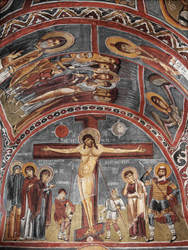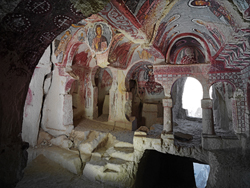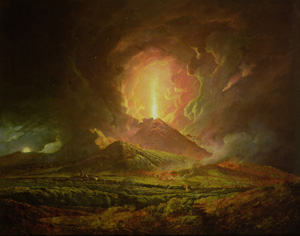
Vaults of Heaven: Visions of Byzantium

(Closing Date Extended)
Exhibition of Large-scale Photographs by Turkish Photographer Ahmet Ertug
Exhibition of Large-scale Photographs by Turkish Photographer Ahmet Ertug
The grandeur of Byzantine Christian art—preserved through the ages in early Christian churches in the Cappadocia region of Turkey—is the focus of a large-scale photography exhibition at the Penn Museum in Philadelphia.
Vaults of Heaven: Visions of Byzantium, an exhibition of 13 color photographs by renowned Turkish photographer Ahmet Ertug, is currently on view at the Penn Museum. Ertug's photographs document the interiors of three churches—the Karankik Kilise (Dark Church), the New Church of Tokali (Buckle Church), and the Meryem Ana Kilisesi (Church of the Mother of God)—all more than 1,000 years old and all UNESCO World Heritage Sites. The photographs include close-up views of elaborate wall paintings depicting classic Christian scenes from the life of Christ and images of saints. Also included are images revealing the dramatic interior architecture of these churches, places that have inspired, and continue to inspire generations of worshippers and admirers.
 Photographer Ahmet Ertug, a 1974 graduate of the Architectural Association School of Architecture in London, practiced architecture in England, Iran, and Turkey. His commitment to photography started with a year-long Japan Foundation Fellowship to study architecture in Japan, where he traveled extensively and photographed the ancient temples, Zen gardens, and festivals. Later, home in Istanbul, he has photographed much of that city's impressive Byzantine, Ottoman, and Roman remains, using a large-format camera that has enabled him to capture their full splendor. In the 1980s, he established his own publishing house, producing 25 specially designed books of his photographs that are now recognized for their innovation in the printing industry.
Photographer Ahmet Ertug, a 1974 graduate of the Architectural Association School of Architecture in London, practiced architecture in England, Iran, and Turkey. His commitment to photography started with a year-long Japan Foundation Fellowship to study architecture in Japan, where he traveled extensively and photographed the ancient temples, Zen gardens, and festivals. Later, home in Istanbul, he has photographed much of that city's impressive Byzantine, Ottoman, and Roman remains, using a large-format camera that has enabled him to capture their full splendor. In the 1980s, he established his own publishing house, producing 25 specially designed books of his photographs that are now recognized for their innovation in the printing industry. His photographs have been exhibited widely around the world; a permanent exhibition of his Hagia Sophia photographs is on display in the upper gallery of Hagia Sophia in Istanbul.
His photographs have been exhibited widely around the world; a permanent exhibition of his Hagia Sophia photographs is on display in the upper gallery of Hagia Sophia in Istanbul.
Photos:
Top: Karanlik Kilise (Dark Church), Mid 11th century, Göreme, Turkey.
The tympanum (the semicircular surface above the entry) is decorated with an image of the Crucifixion. Above left, on the vaulted ceiling, is an image of the Betrayal of Judas. Above right is the archangel Phlogotheel. Photograph by Ahmet Ertug, 2005-2006.
Bottom: Meryem Ana Kilisesi (Church of the Mother of God), first half of the 11th century, Göreme, Turkey.
The church's arcade bears images of John the Evangelist (left), Daniel (center), and John the Baptist (right). Photograph by Ahmet Ertug, 2005-2006.
Top: Karanlik Kilise (Dark Church), Mid 11th century, Göreme, Turkey.
The tympanum (the semicircular surface above the entry) is decorated with an image of the Crucifixion. Above left, on the vaulted ceiling, is an image of the Betrayal of Judas. Above right is the archangel Phlogotheel. Photograph by Ahmet Ertug, 2005-2006.
Bottom: Meryem Ana Kilisesi (Church of the Mother of God), first half of the 11th century, Göreme, Turkey.
The church's arcade bears images of John the Evangelist (left), Daniel (center), and John the Baptist (right). Photograph by Ahmet Ertug, 2005-2006.
- Pompeii Lecture Series: Life and Death in Herculaneum
- When:
- 02:00PM - 03:30PM
- Where:
- Penn Museum - Philadelphia
- Category:
- Lecture
- Add To My Calendar:

Description
 Sunday, November 17, 2:00 pm
Sunday, November 17, 2:00 pmPompeii Lecture Series
Herculaneum: The Archaeology of Catastrophe—Life and Death in a Roman Resort Town
Dr. Janet Monge, Curator-in-Charge, Physical Anthropology Section, speaks. On a hot summer day in the bustling Bay of Naples, Mt. Vesuvius exploded and rained down superheated gas and lava onto the nearby towns of Pompeii and Herculaneum. Some inhabitants of Herculaneum escaped into beach caves, which were used to store the boats for the heavy marine traffic into the cove bay. Their deaths by heat shock—instantly killing victims by vaporizing their soft tissues but preserving their hard, bony skeletons under layers of volcanic ash—affords a unique opportunity to study life and death among the ancient Romans, in ways that are truly unique in the study of the bioarchaeology of the ancient world. Admission: $10, general public; $5, Penn Museum members and Franklin Institute members.

No comments:
Post a Comment